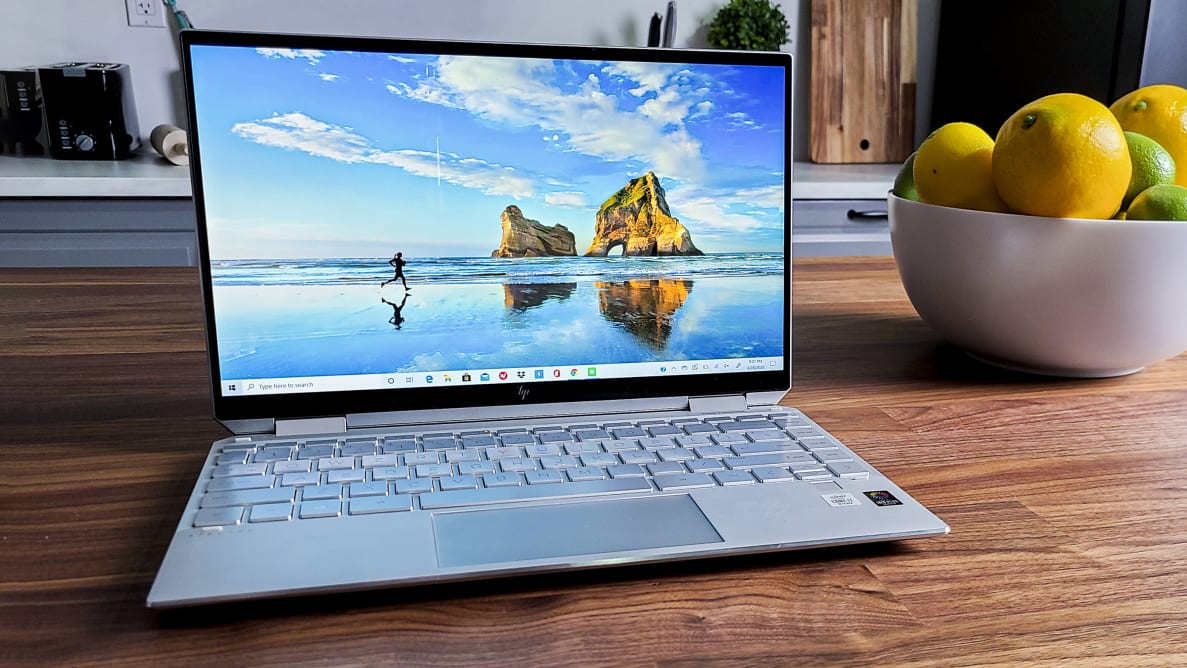Pros
-
Great design
-
Beautiful display
-
The keyboard is a dream
Cons
-
Starting price a little high
We've adored the HP Spectre line of laptops since they debuted, but they could never quite stick the landing. Previous iterations were awesome, but there was always a wonky trackpad or a screen with massive bezels holding it back. Though the latest version's starting price is a bit above the Dell XPS 13 and Apple's MacBook Air, the versions we recommend are all in the same ballpark.
That sets up an interesting question: has HP's Spectre finally surpassed Dell and Apple to be the best 13-inch laptop around?
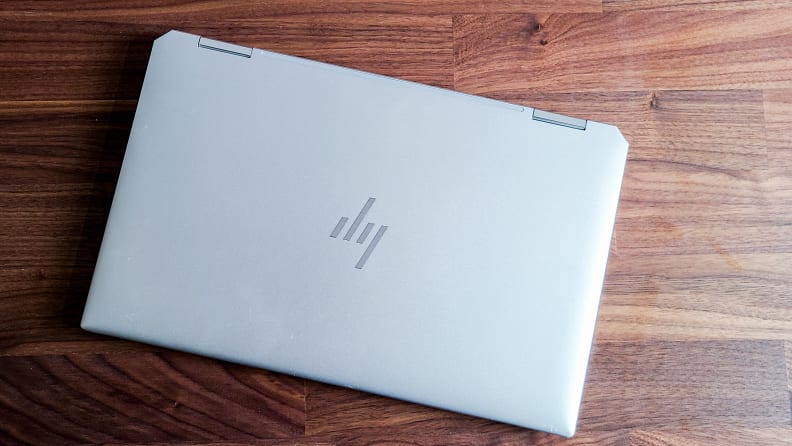
The HP Spectre x360 is a fantastic laptop with phenomenal design.
About the HP Spectre x360 13t
HP's Spectre x360 13t has been around for a few years, but its design is refreshed every year. This iteration was last updated late in 2019 with a new display, slightly modified design, and 10th-gen Intel Core processors. It offers a 10th-gen i5 at a baseline, though the unit we tested utilizes an i7 and is actually available for the same starting $1,199 price when on sale. Here's how the rest of the specs stack up:
- Processor: 10th-gen Intel core i7-1065G7 (4 cores, 1.3GHz, 3.9GHz boost, 8MB cache)
- Storage: 512GB NVMe M.2 SSD (up to 2TB)
- RAM: 8GB Memory (up to 16GB, not user-upgradeable)
- Screen: 13.3-inch 1080p IPS WLED screen (up to 4K AMOLED available)
- Battery: 4-cell 60Wh Li-ion
- Ports: 3.5mm headphone jack, 1 USB 3.1 type A (charging), 2 USB 3.1 type C (power delivery 3.0, DisplayPort 1.4, charging)
- Charger: 65W USB Type-C adapter
- Graphics Card: Intel Iris Plus (integrated)
- Wireless: 802.11ax (WiFi 6) with Bluetooth 5
- Webcam: HP TrueVision HD IR Camera
- Warranty: 1-year limited warranty, 90 days phone support
- Weight: 2.88lbs and up
- Dimensions: 12.08 x 7.66 x 0.67 in
As with most HP laptops, you can configure this one to your heart's content, with faster processors, more memory, more storage, and a range of display options. Unfortunately, most portable laptops in this space feature non-upgradeable RAM, and that's the case here. You can at least swap out the SSD, adding more storage if you need it later (once prices have come down).
Otherwise, your options mostly come down to two things: do you want the OLED display, and do you want an LTE WWAN modem for on-the-go connectivity? Picking either option requires stepping up to the i7 processor, 16GB of soldered RAM, and usually the "Nightfall Black" color instead of Silver or Blue.
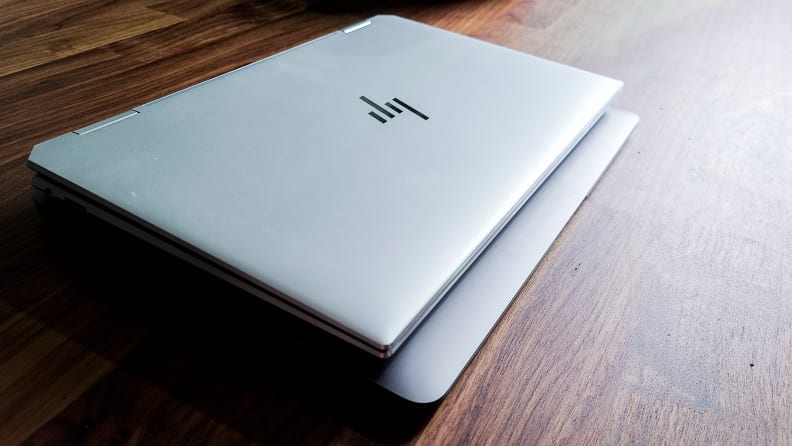
The HP Spectre x360 13t isn't as tall as the MacBook Air, so it's more portable but has less screen and trackpad space.
What We Like
The design is gorgeous, as usual
HP's laptop designs just work for me. The "gem cut" corners, the beveled sides, the sharp lines, the slanted "HP" logo—it all just goes well together. It's not understated the way Apple's MacBook line can be, but it's not overly flashy. It has just enough character to it that it stands out from the crowd, and frankly it makes Dell's XPS lineup seem boring.
That said, HP isn't sacrificing a great deal to get there. It squeezes an extra USB-C port into the corner cut-out, and it uses a trapdoor-like design on the left side to accommodate a full USB-A port without making the laptop any thicker. The 360 degree hinge is also just right, offering plenty of resistance at any angle so you can easily flip it around and use it as a touchscreen, tent, whatever you need.
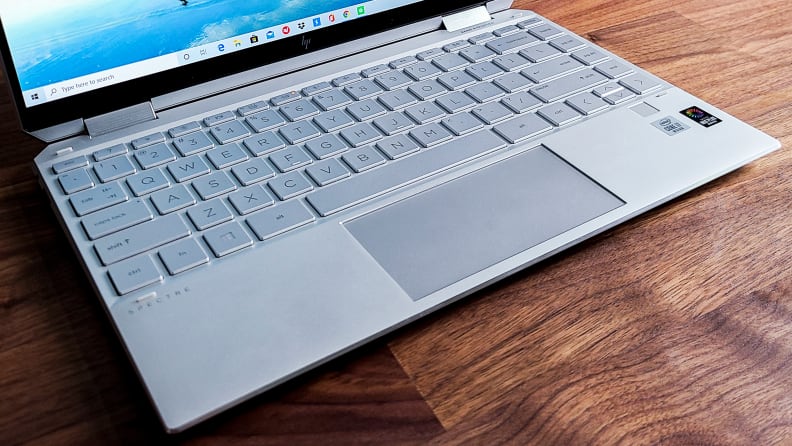
The HP Spectre x360 13t's trackpad now uses Microsoft Precision Touchpad drivers and feels much smoother to use.
The keyboard and touchpad are great to use
Though HP's Elite Dragonfly has won me over as having the best keyboard, it's only because it's ever-so-slightly sunk into the deck of the laptop. The Spectre's keyboard is raised a bit more, so it can make jumping from key to key a little more error-prone. The keys have a near-perfect level of travel and resistance though, and both are fairly quiet—a far cry from the click-clack sound of using the MacBook Air.
In my tests I was able to pretty easily clear 90 words per minute on the Spectre, which is about average for a premium laptop. I didn't have any trouble finding trickier keys, and all the important stuff is where it needs to be.
Perhaps most importantly, though, HP has once again opted for a Microsoft Precision Touchpad, ditching the Synaptics-driven pads that it used in previous Spectre models. Truth be told the Synaptics ones have been fine for a year or two, but I find the MPT drivers more consistent. It's just one less thing that would've given you pause on previous Spectre laptops that is no longer a concern.
Excellent performance, with battery life to spare
Though the Spectre isn't the fastest laptop we've tested recently, its quad-core 10th-gen Intel i7 more than held its own in single and multi-core benchmarks. Though you'll only be able to get it with the late-2019 G-series 10th-gen processors for now, we expect it to get updated with the latest H-series chips later this year.
My typical workload includes about 40 Chrome and Firefox tabs, spreadsheets, Photoshop, Spotify, and more all running simultaneously. The Spectre not only handled it all easily, it did so without the blaring fan noise of my typical work machines, an 8th-gen Dell XPS 13 and a 2017 MacBook Pro. The laptop also doesn't get very hot to the touch, with most of the heat exiting at the back of the machine beneath the screen where you'll barely feel it.
In our battery life benchmarks, the Spectre held its own extremely well. Our test involves scrolling through a list of 50 popular websites at regular intervals with the screen set to 200 nits (about 60% brightness), which knocked the Spectre out in just under 8 hours. That was just below the XPS 13, but on par with the new MacBook Air and similar models like the Lenovo Yoga C740 and above the Acer Swift 5, Microsoft Surface Pro 6, and Surface Laptop 2.
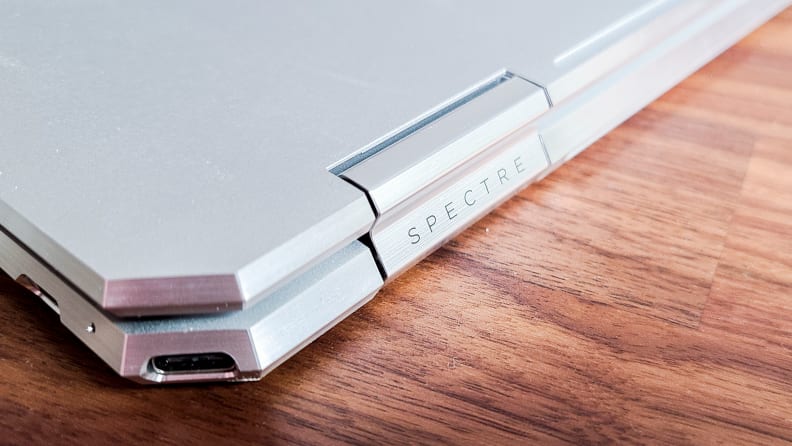
The Spectre series is HP's premium line of consumer laptops.
A gorgeous screen (even if you don't pay for 4K)
Our test unit here has a 1080p screen, rather than the upgraded AMOLED 4K option, but it's great. The screen is vibrant, extremely bright, and offers plenty of contrast if you want to use it for photo editing, video editing, video games, or Netflix.
It's bright enough to use in moderate daylight, with a peak brightness well over 400 nits. The screen is reflective (like most touchscreens), but at the right angle it's easy to see what you're doing even when you're outside or in a bright room.
While a 4K AMOLED display can take image quality to another level in the right situation, we're actually typically in favor of 1080p laptop screens. In most cases it's more than sufficient for what you need to do, and higher-resolution displays typically drag down a machine's battery life. It's up to you, but if I were buying this laptop I'd get the 1080p screen.
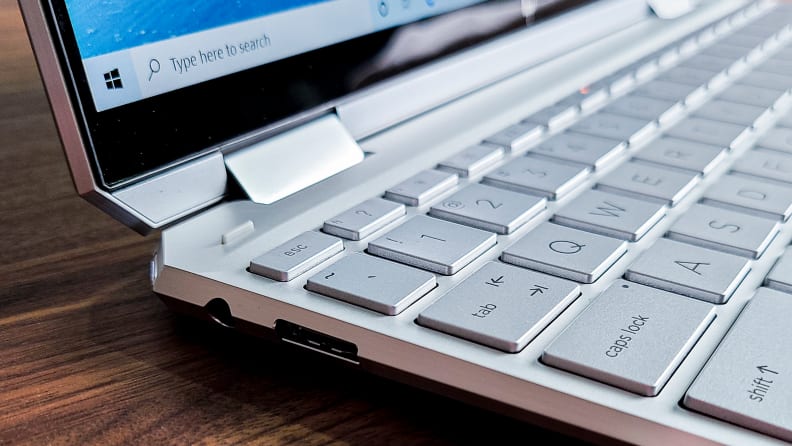
The HP Spectre x360 13t features a standard USB-A port with a trapdoor design so it takes up less room.
Just the right selection of ports
USB-C is fantastic. I love it. But there are still plenty of times when a standard USB Type-A port is useful. The Spectre manages to fit one in, despite the razor-thin chassis.
It uses a neat little trapdoor design that expands to accommodate the larger USB-A cable, collapsing down to a smaller size when not in use. You still get two USB-C ports, and all three can be used for charging the machine, though the included charger is USB-C.
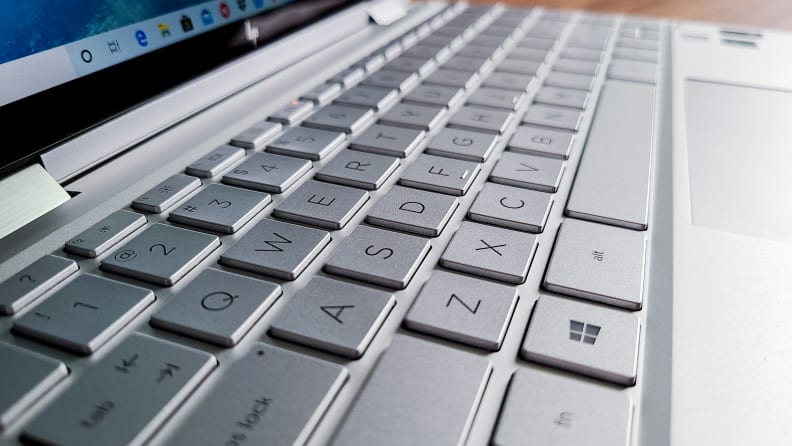
The HP Spectre x360 13t has a keyboard with excellent, long travel.
What We Don't Like
A small trackpad will put some people off
One of the best things about premium laptops in 2019 and 2020: screens with minimal bezels around them. This allows laptop manufacturers to drastically slim down their designs, but it means that there is much less space for the acres of trackpad people may be used to.
Though the Spectre x360 doesn't have the smallest trackpad we've seen, it definitely pads its stats a bit by offering more lateral space than is typical. If you do a lot of vertical scrolling you may need to turn the sensitivity up so you don't hit the edges that often.
Storage is upgradeable, but RAM is not
Though adding more RAM to your laptop is a dying art, with most premium laptops soldering it in, it's still an option we like to see. Going from 8GB to RAM to 16GB is an $80 upgrade here, but it is a bit cheaper to buy it later (especially for laptops that ship with one 8GB stick and a free slot) and those prices come way down over time.
Storage being upgradeable is usually a given, but we've seen both new models from Dell and Apple remove this option. Not only is non-removable storage a huge negative for consumers (NVMe SSDs are very expensive but prices are poised to plummet with new video game consoles opting for the technology), it actually is a big problem for your data down the road.
Ever have a laptop just stop working on you or a screen get cracked? It's much easier to recover your data by taking your drive out and moving it to a new machine than having to send it in for service because it's soldered into the body.
Mid-range laptops give high-end machines like this a serious run for your money
Other than the ongoing saga of Apple's Horrible, No Good, Very Bad Keyboards, the dominant narrative around laptops has been fancy machines getting thinner, lighter, and faster.
One thing that has gone unnoticed? Mid-range machines area amazing these days. HP, Dell, Lenovo, Asus, Acer, and Microsoft all make machines that cost well under $1,000 that don't skimp on design while still offering the same brand-new processors as these flagship laptops.
For HP, look no further than the Envy lineup. Though the machines opt for a bit more plastic than the Spectre lineup, the design language is nearly all there, and you can get a similar level of performance for $800 (or less) without breaking a sweat. If money is tight, something like the Envy or Dell's Inspiron 7000 is pretty hard to pass up.
That makes paying $1,200 or more for the Spectre a bigger leap than you might expect. There used to be a big gulf in design quality between this echelon of machines and the mid-range and entry-level devices, but no longer. I'd still prefer the Spectre given the choice, but I'd have to think about it.
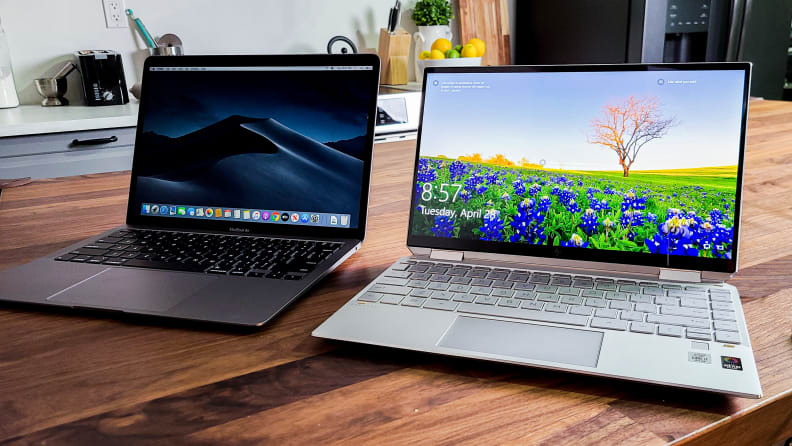
The HP Spectre x360 13t compares very well to Apple's redesigned MacBook Air.
Should You Buy It?
Hell yes. The HP Spectre x360 has everything we look for in a premium laptop: jaw-dropping design, all-day battery life, top-of-the-line speed, and enough creature comforts that you don't mind shelling out the extra money—especially compared to the much more expensive entry-level MacBook Pro models that tend to define most people's concept of a "high-end" laptop.
The one thing that gives us pause is the incredibly fierce competition. The new 2020 MacBook Air is back with a vengeance, with a keyboard that is a far cry from the embarrassment of the last few years. Dell continues to engineer the life out of its XPS 13 machines, with battery life that surpasses the Spectre and a chassis that is thinner—though that comes with a variety of compromises.
It's worth noting that both the Dell XPS 13 (7390) and the MacBook Air (2020) start at a cheaper $999 MSRP right now, though that nets you a dual core i3 with the MacBook as opposed to a quad core i5 on the Dell. The Spectre also has a quad core i5 to start with, but it starts at $1,199—though you can get upgraded to the 10th-gen i7 and a 512GB SSD for the same price right now. That config would cost you $1,449 for the MacBook and $1,549 for the Dell, so we expect the value proposition to shift dramatically depending on your needs, especially as time goes on.
In truth, I'd be hard-pressed to pick a favorite from any of these three, but I might lean toward the Spectre with an i7 and 512GB SSD if I were putting my own money down. Either way, they're all spectacular laptops that offer class-leading design, battery life, speed, and portability. When friends and family ask me which laptop to buy, chances are these are the ones I'm going to point them to.
Meet the testers
TJ is the former Director of Content Development at Reviewed. He is a Massachusetts native and has covered electronics, cameras, TVs, smartphones, parenting, and more for Reviewed. He is from the self-styled "Cranberry Capitol of the World," which is, in fact, a real thing.
Ashley Barry-Biancuzzo is a valued contributor to the Reviewed.com family of sites.
Checking our work.
Our team is here to help you buy the best stuff and love what you own. Our writers, editors, and experts obsess over the products we cover to make sure you're confident and satisfied. Have a different opinion about something we recommend? Email us and we'll compare notes.
Shoot us an email
